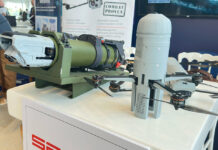

In recent weeks Iran has introduced new guided weapon systems claimed to be based on indigenous developments. Among these weapons are the Shahed 129 attack Unmanned Aerial Vehicle (UAV), precision guided version of the Zelzal medium range rocket, and Taer medium-range air-defense missile, positioned to be a precursor for the country’s new category of air defense weapon systems.
As for the improved precision of Zelzal-2, Major General Mohammad Ali Jafari, Commander of the Islamic Revolution Guards Corps confirmed the level of accuracy of Zelzal rockets has been increased, “the precision [of Zelzal rockets has been increased and their margin of error has been lowered to less than 50 meters,” the IRGC commander explained.
General Jafari confirmed the country’s missile development is back on track, following the devastating explosion occurred during a test, on November 12, 2011. The explosion killed 17, among them General Hassan Tehrani Moqaddam, known as the father of the Islamic Republic missile technology. “Iran’s missile development has been delayed in about six months after this event” Jafari said in a recent interview to the Fars news agency. He said the explosion took place at the IRGC center in the vicinity of Tehran, when scientists were conducting research on solid fuel for satellite carries. “It was just a part of our missile research program that was hit by the accident.” General Jafari said, “The accident could only delay our research for 6 months and now the program is back on.”
As part of its strategic missile program, Tehran is deploying part of its missiles on transportable launchers. While missiles propelled by solid-rocket, maintained in high readiness and are ready for launch within minutes, missiles propelled by liquid fuel require lengthy refueling and are therefore much more vulnerable to preemptive attack. These missiles are likely to be stored in underground silos – such as the Jask-2, recently unveiled by the Iranian military. Such a facility was first unveiled during the opening stage of the 2011 ‘Great Prophet 6’ exercise, where ballistic missiles were fired against, and destroyed a naval surface target.
According to senior commanders of the IRGC Aerospace Force, Iranian experts have been busy with developing the technology and infrastructures for the underground silos for the last 15 years. The pads have the capability to launch different types of missiles, including long-range Shahab class missiles.
Iran is also developing a new air defense missile system dubbed Raad. 6×6 transporter vehicles each carrying three ‘Taer’ missiles were displayed on the annual military march in Tehran in September. The system is claimed to be of a local development, include a radar system, fire control complex and multiple missile transporter-launchers. The missile is said to be effective against aircraft, helicopters and drones, it has an intercept range of 50 kilometers and the system is claimed to be effective at altitudes from70 to 70,000ft (22 km).
To learn about the new Iranian missiles, Sign up for Defense-Update Premium Account to know more…
In addition to the medium air defense systems Iran has also invested in the development of early warning systems based on indigenous design. In June 2011, the IRGC marked the first deployment of the long-range Ghadir radar system, allegedly capable of tracking aerial targets at ranges up to 500 km (‘coverage of 1,100 km range’) and at altitude of 300km, making it capable of tracking satellites orbiting at ‘very low earth orbits’, according to Iranian sources. (most LEO satellites are, however, orbiting at higher altitudes). The radar operates over a wide frequency range. The Iranians also said their new radar can detect radar-evading aircrafts (stealth), cruise missiles and ballistic missiles as well. Another radar developed indigenously is capable of detecting Unmanned Aerial Vehicles (UAVs), assisting air defense weapon systems to engage such targets.
Iran Flexing Muscles: (Subscriber version)
Part 1: Combat UAVs
Part 2: a New ‘Stealth’ Frigate
Part 3: Air Defense & Ballistic Missiles
















